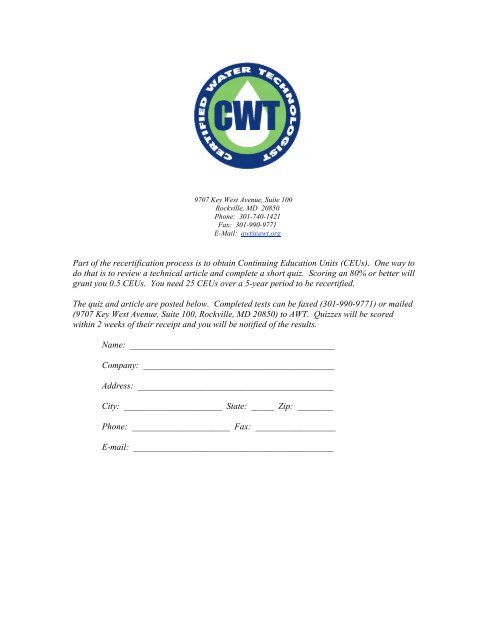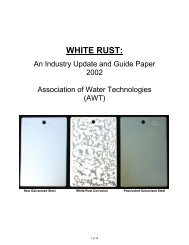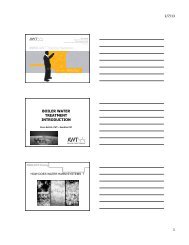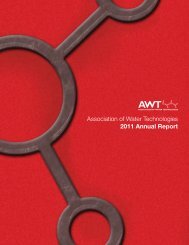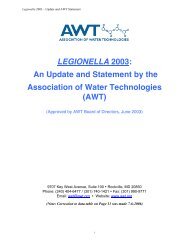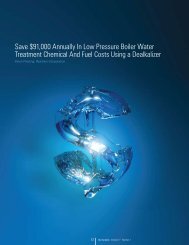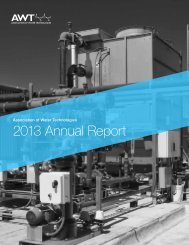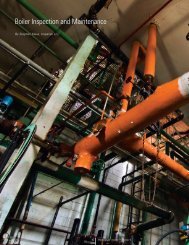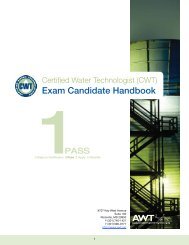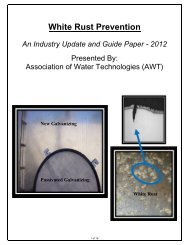DEHA - Association of Water Technologies
DEHA - Association of Water Technologies
DEHA - Association of Water Technologies
You also want an ePaper? Increase the reach of your titles
YUMPU automatically turns print PDFs into web optimized ePapers that Google loves.
2001 Winter3. VolatilityIn addition to oxygen scavenging and metal passivating capabilities, another keyadvantage <strong>of</strong> <strong>DEHA</strong> is volatility. Not only does <strong>DEHA</strong> scavenge oxygen and passivatemetal in the feedwater and boiler portions <strong>of</strong> a steam boiler cycle, it also volatilizes withthe steam to provide complete system protection (Rossel et al, 1991).The fact that <strong>DEHA</strong> is volatile represents an enormous advantage in condensate systemtreatment because most <strong>of</strong> it is transported and absorbed into the condensate systemallowing it to:• Passivate condensate system metallurgy preventing corrosion• Scavenge oxygen if it enters the condensate system preventing corrosion• Reduce corrosion byproduct transport to the boiler minimizing the potential for boilerdeposition and corrosion• Improve equipment reliability and efficiency• Minimize overall condensate system corrosion reducing the related maintenance costs4. Thermal DegradationUnder the action <strong>of</strong> heat in the system <strong>DEHA</strong> degrades to form two neutralizing amines,diethylamine and ethylmethylamine. In many instances it will be possible to reduce oreliminate neutralizing amine feed while maintaining the condensate pH in the desiredrange with <strong>DEHA</strong> in the system. Over the past 20 years <strong>DEHA</strong> has been used in manysystems to elevate condensate pH as well as remove oxygen from the system eliminatingthe requirement to apply neutralizing amines (Ellis et al, 1987).5. Toxicity<strong>DEHA</strong> has very low toxicity making it safe and easy to handle in typical applicationsystems. One standard acute oral toxicity test measures LD 50 , the amount <strong>of</strong> a substancerequired to kill 50% <strong>of</strong> the laboratory population <strong>of</strong> a given species under test conditions.The LD 50 numbers for <strong>DEHA</strong> are 2190 mg/kg on rats and 1300 mg/kg on rabbits. Theseare very high dose rates. As an example from a safety and handling standpoint, in thistype <strong>of</strong> testing <strong>DEHA</strong> exhibits less than 10% <strong>of</strong> the toxicity <strong>of</strong> hydrazine (Cuisia et al,1983).6. <strong>DEHA</strong> Applications<strong>DEHA</strong> has been successfully utilized to treat a variety <strong>of</strong> low pressure and high-pressureboiler systems replacing both hydrazine and sulfite as well as competitive organic oxygenscavengers. It can be used in any type <strong>of</strong> boiler system where the feedwater temperatureexceeds 180°F under alkaline conditions (pH 8.5 or higher). However, <strong>DEHA</strong> does nothave FDA approval. Therefore, it cannot be used in systems where the steam comes intodirect contact with food. <strong>DEHA</strong> has also found many applications aside fromconventional boiler feedwater treatment over the years.
2001 WinterWhile hydrazine is a strong passivating agent, it functions as a reducing agent in thefeedwater/boiler phases <strong>of</strong> the system. Not only does <strong>DEHA</strong> perform the same oxygenscavenging/passivating functions in these areas, it also passivates the entire steamcondensate system due to its volatility. In addition, hydrazine thermally degrades toammonia, which can be very corrosive to yellow metals in the presence <strong>of</strong> oxygen. Bycomparison, ammonia generation from <strong>DEHA</strong> is only 10 to 20 % <strong>of</strong> that generated byhydrazine.The second significant advantage <strong>of</strong> <strong>DEHA</strong> over hydrazine is its toxicity (Cuisia et al,1983). The LD 50 for hydrazine is 82 mg/kg on rats and 91mg/kg on rabbits. This is thedosage <strong>of</strong> hydrazine necessary to kill 50% <strong>of</strong> a laboratory population <strong>of</strong> these speciesunder test conditions. The same LD 50 numbers for <strong>DEHA</strong> are 2190 mg/kg on rats and1300 mg/kg on rabbits. In essence, from a safety and handling standpoint, <strong>DEHA</strong> exhibitsless than 10% <strong>of</strong> hydrazine toxicity. Hydrazine has also been identified as a suspectedanimal carcinogen by the U.S. government. In today's changing marketplace, with aheightened emphasis on employee health and safety in the working environment,employee health and safety is a significant issue with all water treatment customers.SulfiteSodium sulfite has been widely used as an oxygen scavenger in boiler systemsparticularly at lower pressures. It is non-toxic and relatively easy to apply. It can be usedin either solid or liquid (sodium bisulfite dissolved in water) form.On a stoichiometric basis 7.9 mg/L <strong>of</strong> sodium sulfite is required to react completely with1 mg/L <strong>of</strong> oxygen. In lower pressure systems it is generally recommended that an excess<strong>of</strong> 20-40 mg/L <strong>of</strong> sodium sulfite be maintained in an operating boiler.Use <strong>of</strong> sodium sulfite adds considerable solids to the boiler water, which limits its use insystems utilizing high purity boiler feedwater.Sodium sulfite does not promote passivation in boiler feedwater or boiler water systems.The ability <strong>of</strong> sulfite based products to minimize corrosion stems solely from theircapability to remove oxygen from the water.Sodium sulfite is totally non-volatile. It is used exclusively to protect the boiler feedwatersystem and the boiler system. Sulfite based products cannot be used to protect the steamcondensate system.Compared with sulfite, <strong>DEHA</strong> <strong>of</strong>fers many benefits due to its volatility and ability topromote passivation <strong>of</strong> steel surfaces in the system.
2001 WinterConclusionMany years <strong>of</strong> application have clearly demonstrated the excellent performance <strong>of</strong> <strong>DEHA</strong>as a passivating agent and oxygen scavenger for the entire boiler feedwater, boiler waterand steam condensate system. Its many advantages in application and cost-effectivenessmake it the oxygen scavenger <strong>of</strong> choice for most types <strong>of</strong> steam generating facilities.ReferencesBain, D.I., Engstrom, G.G., and Fryer, M.T (1994). "Recent Advances in Volatile OxygenScavenger Technology," Corrosion , page 201.Cuisia, D.G., Rudolph, J.W., Hwa, C.M. and Tehle, Jr. T.E. (1983). "New OxygenScavenger for Boiler Systems," Corrosion, page 83.Ellis, D.M., Cuisia, D.G. and Thompson, H.W (1987). "The Oxidation and DegradationProducts <strong>of</strong> Volatile Oxygen Scavengers and their Relevance in Plant Applications,"Corrosion , page 432.Rossel, K.L., Kelly, J.A., Richardson, J. (1991). "Steam Cycle Protection for Pulp andPaper Systems," Corrosion, page 184.Schneider, L. L. and Hutchins, D.C (1986). "Alternative Chemical Treatment forCyclically Operated Units - <strong>DEHA</strong>," L.L. Schneider and D.C. Hutchins. International<strong>Water</strong> Conference Journal, page 21.Thompson, H.W. (1986). "Use <strong>of</strong> Oxygen Scavengers in Wet Lay-up <strong>of</strong> Boilers andAuxiliaries," H.W. Thompson. Corrosion, page, 174.
2001 WinterTechnical Article Review QuizThe Questions for the exam may be answered by reading and understanding the Winter 2001Analyst Article titled “Diethylhydroxylamine (<strong>DEHA</strong>) A Volatile Oxygen Scavenger for BoilerSystem Treatment “by Frank Kasinecz. The correct answers are derived from that article and anydisputed answers will be referred back to that article for justification.1. From a stoichiometric standpoint, for every 1 mg/L <strong>of</strong> Oxygen you will need to add,a. 0.5 mg/L <strong>of</strong> <strong>DEHA</strong>b. 1.2 mg/L <strong>of</strong> <strong>DEHA</strong>c. 22.0 mg/L <strong>of</strong> <strong>DEHA</strong>d. 60.0 mg/L <strong>of</strong> <strong>DEHA</strong>2. <strong>DEHA</strong> has the ability toa. remove all traces <strong>of</strong> Oxygen.b. prevent scale formation.c. degrade to a single neutralizing amined. prevent formation <strong>of</strong> a passive magnetite film3. <strong>DEHA</strong> also has the ability toa. passivate only the condensate system.b. scavenge magnetite in the condensate system.c. reduce corrosion byproduct transport to the boiler.d. remove oil contaminants in boiler vessels4. Under the action <strong>of</strong> heat in the system <strong>DEHA</strong> degrades to form,a. Cyclohexylamineb. Sodium Sulfitec. Hydrazined. Diethylamine and ethylmethylamine5. Successful <strong>DEHA</strong> treatment requires boiler system feedwater temperature to be at least,a. 100°Fb. 100°Cc. 180°Fd. 180°C6. For wet storage or lay-up <strong>of</strong> a boiler <strong>DEHA</strong> should be maintained at,a. 5 mg/Lb. 50 mg/Lc. 500 mg/Ld. 5000 mg/L
2001 Winter7. In low to moderate pressure industrial boiler systems, an initial feedwater <strong>DEHA</strong> dosageshould bea. 3-5 mg/Lb. 30-50 mg/Lc. 300-500 mg/Ld. 3000-5000 mg/L8. When replacing Hydrazine with <strong>DEHA</strong> the dose rate willa. remain the same as hydrazineb. have to increase by a factor <strong>of</strong> 2.c. reduced by 50%d. have to increase by 40%9. Sodium Sulfite and <strong>DEHA</strong>a. add considerable solids to the boiler waterb. promote passivation in the boiler feedwater or boiler water systems.c. can be fed separately to the same boiler system.d. have FDA approval for use in direct steam contact applications with food.10. <strong>DEHA</strong> has been utilized as an oxygen scavenger in boiler systems for the pasta. 5 yearsb. 20 yearsc. 50 yearsd. 75 years


